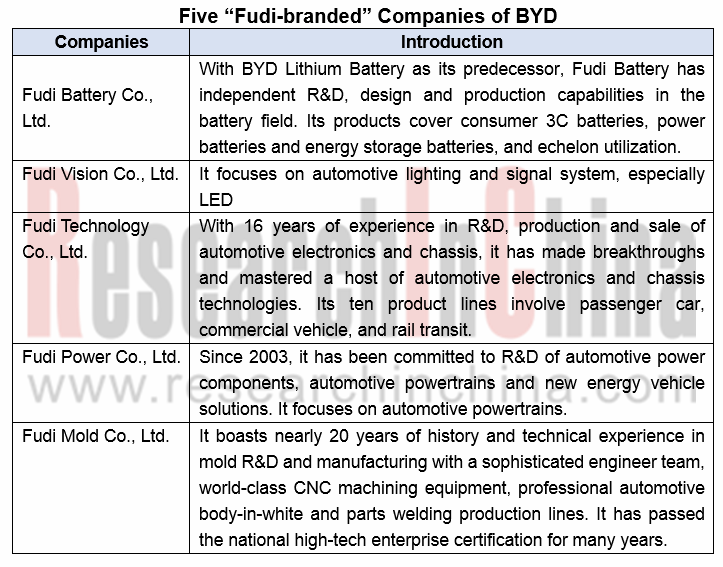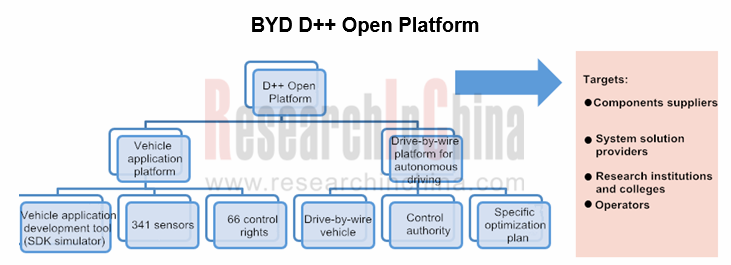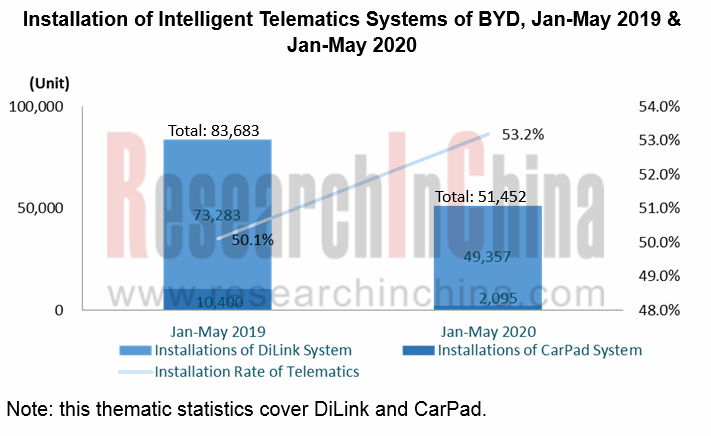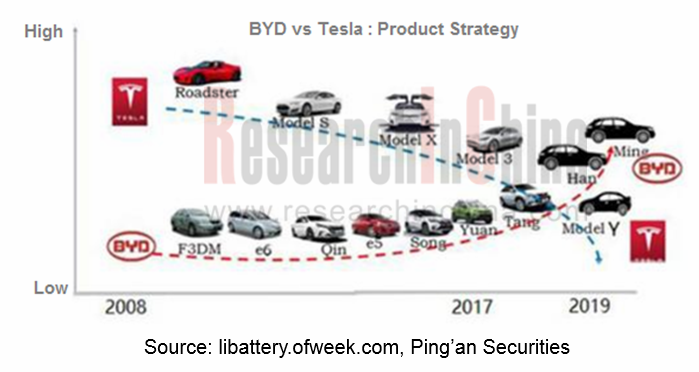BYD CASE (Connected, Autonomous, Shared, Electrified) Layout and Strategy Research Report, 2020
Research on BYD's CASE (Connected, Autonomous, Shared, Electrified): Absence of software and operating system
As we all know, BYD excels in hardware.
BYD started with rechargeable batteries and forayed into automotive sector in 2003. It established a joint venture brand "DENZA" with Daimler in 2010, and accessed to the rail transit field in 2016. BYD has four business segments to date, including automotive, mobile phone components & assembly, rechargeable batteries & photovoltaic, and Skyshuttle.
What efforts have BYD made in CASE?
Electrification: with technical knowhow about core components
BYD boasts a full-fledged industry chain concerning vertical integration of core new energy vehicle components such as power batteries and electric drive systems. It ranks second in the Chinese power battery market by share, and released in March 2020 the next-generation power battery -- "Blade Battery”. Besides, it takes the second place in the Chinese IGBT market by share as the only Chinese automaker with a complete IGBT industry chain. Its IGBT4.0 has been up to the international mainstream technology level.
BYD’s latest e-Platform is divided into 5 standard modules:
- Three-in-one drive system -- a three-in-one module comprised of drive motor, electric control and decelerator;
- Three-in-one high-voltage system -- a three-in-one module encompassing high-voltage charging and distribution system on-board charger (OBC), DC-DC converter, and power distribution box (PDU);
- A low-voltage all-in-one PCB integrating various body controllers;
- A large intelligent rotating screen with "DiLink" system;
- A power battery module.
In March 2020, BYD established five “Fudi-branded” companies to spin off major new energy vehicle parts business.

BYD’s opening strategy has succeeded initially: the automakers like Changan Automobile, Changan Ford, and BAIC BJEV will adopt BYD’s ternary lithium/LiFePO4 batteries.
Regarding the opening strategy, BYD launched the D++ open platform covering intelligence and connectivity in 2018. By opening up 341 sensors and 66 control rights, it will create a standard platform for smart car hardware.

Intelligence: installation rate of ADAS is at the medium level in China
Among Chinese passenger car brands, BYD is positioned in the middle in terms of ADAS installation rate. In April 2020, BYD introduced DiPilot, a L2 driver assistance system (combining big data algorithms) which can learn driving habits of the driver. As concerns higher level of autonomy, BYD has yet to consider L3 development but its research and development of L4/L5 technologies is in the pipeline.
DiPilot has been installed in BYD Han, a model launched on market in July 2020. DiPilot packs 3 radars (1 in the front and 2 at the rear), 12 ultrasonic radars and 5 cameras (1 mono camera and 4 surround-view cameras). The system offers the following capabilities: automatic emergency braking, forward collision warning, adaptive cruise control, low-speed follow mode, traffic jam assist, DiTrainer self-learning, lane departure warning, lane keeping, blind spot detection and automatic parking, as well as vehicle OTA updates available for the first time.
Connectivity: installation rate of telematics remains low
As for connectivity, BYD’s installation rate of telematics stood at 53.2% (including DiLink and CarPad) in the first five months of 2020, lower than other local auto brands such as MG, Roewe, WEY, Geely and Changan.

BYD rolled out DiLink, its new-generation intelligent center console system, in 2018. DiLink 3.0 version has become available after OTA updates and is first mounted on BYD Han. Features of DiLink include: compatibility with more than 3 million Android-based smartphone APPs, screen-split display, interaction with smart bracelet, smartphone NFC key, and in-vehicle camera. In BYD’s next step, face recognition will be added as scheduled.
Sharing: BYD is making attempts and plans to increase investment
BYD still lags well behind its domestic leading peers (e.g., Geely and SAIC) in shared mobility. At present, it not only provides new energy vehicles to local taxi companies but sets up two joint ventures with Didi.
Yadi New Energy Group (Shenzhen Didi New Energy Vehicle Technology Co., Ltd.) was co-funded by BYD (40%) and Didi (60%) in 2015, currently with the registered capital of RMB1.2 billion. The Shenzhen-based joint venture has set up over 20 wholly-owned subsidiaries in South China, Central China and East China, with most of its operations in cities like Shenzhen, Suzhou, Guangzhou, Shenzhen and Nantong. According to its announcement, the company recorded revenues of RMB128 million, RMB183 million and RMB939 million in 2016, 2017 and 2018, respectively, but made ever heavier loss during the three years, up to the loss-making RMB35 million in 2018.
In November 2019, BYD Automobile Industry Co., Ltd. and Beijing Xiaoju Intelligent Automobile Technology Co., Ltd. (“Didi Chuxing”) together invested to establish Meihao Mobility (Hangzhou) Automotive Technology Co., Ltd.. Of the registered capital of RMB1,285 million of the joint venture, BYD contributed 65% or RMB835 million, and Didi Chuxing contributed 35% or RMB450 million.
If for BYD establishment of Yadi New Energy Group is just a move to test the waters, founding Meihao Mobility shows that it pays more attention to mobility market and will seize the initiative in the market.
Predictably, BYD will invest more in shared mobility market, with Yadi New Energy Group and Meihao Mobility as a foundation.
Absence of software and operating system
BYD remains the champion by new energy vehicle sales in China for many years, selling 247,800 NEVs in 2018, a bit above Tesla’s and ranking first worldwide. However, Tesla’s electric vehicle sales posted 366,000 units in 2019, compared with BYD’s 229,500 units, indicating a widening gap between them. From product strategies of theirs it can be seen that Tesla are turning from high-priced models to the low-priced ones, while BYD are developing vehicle models from low prices to high prices.

Entering 2020 when Volkswagen AG is frustrated in its reform in vehicle software and E/E architecture, most insiders become increasingly aware of Tesla’s strong power in software and architecture, the idea of software-defined cars are deeply rooted in people’s minds and traditional big auto brands are stepping up investments into software.
SAIC established a software branch –Z.ONE Software Company at the outset of 2020 and plans to enlarge its software team to 2,200 talents till 2023. In April 2020, Great Wall Motor set up a tier-first division “digitalization center” involving intelligent driving, smart cockpit, digital marketing platform, data middle platform, user operation platform, etc.
Like Tesla, BYD upholds the independent development of core components and system, and they differ in that Tesla is adept at both software and hardware and BYD is expert only in hardware, and that Tesla accomplished vehicle OTA long ago while BYD didn’t achieve vehicle OTA until 2020 (OTA success in the model Han).
Tesla has lavished tens of billions of dollars for building revolutionary E/E architecture, operating system, AutoPilot, and FSD chip for a decade. Is there any opportunity for BYD to start from scratch and address software inadequacies? It is really a hard nut to crack.
Fortunately, BYD is aided by Huawei Technologies since they are in the same city, Shenzhen.
BYD has collaborated with Huawei for a long time, particularly in 2019 when the United States posed sanctions on Huawei and Flextronics ceased its services for Huawei, BYD as the second largest mobile phone foundry service provider in the world took the place of Flextronics and is going all out to secure OEM production of Huawei mobile phones.
In 2020, BYD’s latest Han model get access to Huawei HiCar system and is packed with Huawei’s automotive 5G communication module and new-generation NFC key.
In future, BYD and Huawei are probable to have vertical cooperation in operating system, computing chip, E/E architecture, sensors, among others.
Passenger Car Mobile Phone Wireless Charging Research Report, 2025
Automotive Wireless Charging Research: Domestic Installation Rate Will Exceed 50%, and Overseas Demand Emerges as Second Growth Driver.
The Passenger Car Mobile Phone Wireless Charging Research Repor...
Automotive 4D Radar Industry Research Report 2025
4D radar research: From "optional" to "essential," 4D radar's share will exceed 50% by 2030.
1. 4D imaging radar has transformed from an "optional" to a "must-have" sensor.
4D radar adds the detecti...
China Automotive Multimodal Interaction Development Research Report, 2025
Research on Automotive Multimodal Interaction: The Interaction Evolution of L1~L4 Cockpits
ResearchInChina has released the "China Automotive Multimodal Interaction Development Research Report, 2025"...
Automotive Vision Industry Report, 2025
Automotive Vision Research: Average Camera Installation per Vehicle Reaches 5.2 Units, and Front-View Tricam Installation Exceeds 1.2 Million Sets.
From January to September 2025, the total installa...
Automotive Infrared Night Vision System Research Report, 2025
Automotive night vision research: The rise of infrared AEB, with automotive infrared night vision experiencing a 384.7% year-on-year increase from January to September.
From January to September 2025...
New Energy Vehicle Cross-Domain (Electric Drive System and Powertrain Domain) Integration Trend Report 2025-2026
Electric Drive and Powertrain Domain Research: New technologies such as three-motor four-wheel drive, drive-brake integration, and corner modules are being rapidly installed in vehicles.
Electric dri...
Analysis on Desay SV and Joyson Electronic's Electrification, Connectivity, Intelligence and Sharing, 2025
Research on Desay SV and Joyson Electronic: Who is the No.1 Intelligent Supplier?
Both Desay SV and Joyson Electronic are leading domestic suppliers in automotive intelligence. "Analysis on Desay SV ...
OEMs and Tier 1 Suppliers' Cost Reduction and Efficiency Enhancement Strategy Analysis Report, 2025
ResearchInChina released the "OEMs and Tier 1 Suppliers' Cost Reduction and Efficiency Enhancement Strategy Analysis Report, 2025", summarizing hundreds of cost reduction strategies to provide referen...
Automotive Fixed Panoramic Sunroof and Smart Roof Research Report, 2025
With the intelligent application of car roofs as the core, this report systematically sorts out a series of new products such as fixed panoramic sunroof/openable sunroof, ceiling screen, roof ambient ...
Automotive-Grade Power Semiconductor and Module (SiC, GaN) Industry Research Report, 2025
SiC/GaN Research: Sales volume of 800V+ architecture-based vehicles will increase more than 10 times, and hybrid carbon (SiC+IGBT) power modules are rapidly being deployed in vehicles.
Sales volume o...
Cockpit Agent Engineering Research Report, 2025
Cockpit Agent Engineering Research: Breakthrough from Digital AI to Physical AI
Cockpit Agent Engineering Research Report, 2025 starts with the status quo of cockpit agents, summarizes the technical ...
Prospective Study on L3 Intelligent Driving Technology of OEMs and Tier 1 Suppliers, 2025
L3 Research: The Window of Opportunity Has Arrived - Eight Trends in L3 Layout of OEMs and Tier 1 Suppliers
Through in-depth research on 15 OEMs (including 8 Chinese and 7 foreign OEMs) and 9 Tier 1 ...
China Commercial Vehicle IoV and Intelligent Cockpit Industry Research Report 2025
Commercial Vehicle IoV and Cockpit Research: The Third Wave of Passenger Car/Commercial Vehicle Technology Integration Arrives, and T-Box Integrates e-Call and 15.6-inch for Vehicles
I. The third wav...
Intelligent Vehicle Electronic and Electrical Architecture (EEA) and Technology Supply Chain Construction Strategy Research Report, 2025
E/E Architecture Research: 24 OEMs Deploy Innovative Products from Platform Architectures to Technical Selling Points
According to statistics from ResearchInChina, 802,000 passenger cars with domain...
Research Report on Intelligent Vehicle Cross-Domain Integration Strategies and Innovative Function Scenarios, 2025
Cross-Domain Integration Strategy Research: Automakers' Competition Extends to Cross-Domain Innovative Function Scenarios such as Cockpit-Driving, Powertrain, and Chassis
Cross-domain integration of ...
China Autonomous Driving Data Closed Loop Research Report, 2025
Data Closed-Loop Research: Synthetic Data Accounts for Over 50%, Full-process Automated Toolchain Gradually Implemented
Key Points:From 2023 to 2025, the proportion of synthetic data increased from 2...
Automotive Glass and Smart Glass Research Report, 2025
Automotive Glass Report: Dimmable Glass Offers Active Mode, Penetration Rate Expected to Reach 10% by 2030
ResearchInChina releases the Automotive Glass and Smart Glass Research Report, 2025. This r...
Passenger Car Brake-by-Wire (BBW) Research Report, 2025
Brake-by-Wire: EHB to Be Installed in 12 Million Vehicles in 2025
1. EHB Have Been Installed in over 10 Million Vehicles, A Figure to Hit 12 Million in 2025.
In 2024, the brake-by-wire, Electro-Hydr...